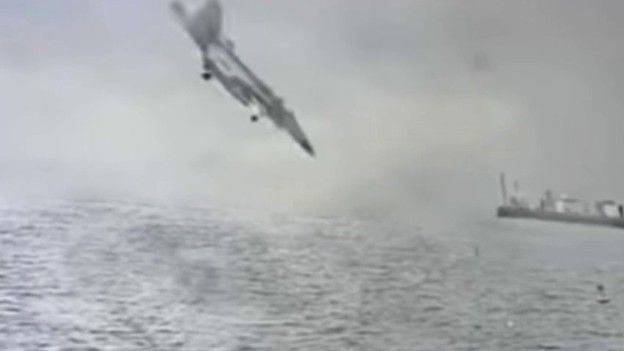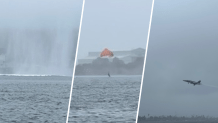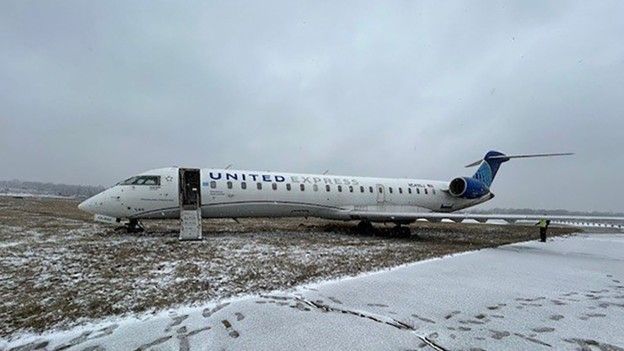ARFF Daily News
Published on:
Thursday the 13th of February, 2025
2 rescued after military plane crashes into San Diego Bay
The EA-18G Growler is the "first line of defense in hostile environments" with several sensors and weapons to combat threats, according to the U.S. Navy
By Christina Bravo and NBC 7 Staff
A military fighter jet with two service members on board crashed into the San Diego Bay near Shelter Island Wednesday, according to San Diego Fire-Rescue.
Rescue crews responded around 10:15 a.m. to reports that a military plane with two service members on board crashed into the water, the SDFD said.
The U.S. Navy confirmed the plane involved was a U.S. Navy EA-18 Growler — a variant of the Boeing F/A-18E/F Super Hornet — assigned to Electronic Attack Squadron (VAQ) 135, based at NAS Whidbey Island, Washington.
A charter fishing boat with H & M Landing was the first on the scene and pulled the service members out of the water. General Manager Frank Ursitti said the captain of the Premier saw the aviators eject from the military plane and immediately turned around to help.
"As all of our crews are trained in lifesaving efforts, immediately came about, turned around picked up both pilots that were in the water," Ursitti said. "And as they were boarding the pilots on the water, [the captain] observed the plane actually ditch into San Diego Bay."
Ursitti said the plane crash happened minutes after the aviators ejected.
Both service members were conscious when they were pulled out of the water, Ursitti said. They were transferred to a U.S. Customs and Border Protection boat and taken to the dock where they were transported to UC San Diego Medical Center, the SDFD said.
The extent of their injuries was not disclosed but the military said their condition was stable.
An EA-18G Growler was involved in a deadly crash during a training flight near Mount Rainier, Washington in October 2024. The service members were with Electronic Attack Squadron (VAQ) 130.
The EA-18G Growler is "the Navy’s first line of defense in hostile environments" with several sensors and weapons to combat threats, according to VAQ-135.
Naval Base Coronado established an emergency operations center as they investigate the cause of the crash.
At 6 p.m. on the evening of the crash, Navy officials provided an update, saying that both aviators were in good condition but would be monitored for 24 hours out of an abundance of caution.
The Navy also said they had located the underwater crash site and that Harbor Security boats were on-site and crews were working to minimize any environmental impact from the downed aircraft.
"The public is reminded to not approach, touch, or collect any debris that may wash ashore," the Navy news release said. "Anyone who encounters suspected aircraft debris should report it to local authorities or call Naval Base Coronado."
While military officials did not provide a cause for the crash, they did say that the investigation was ongoing and that updates would be provided as events warranted.
Point Loma couple witnesses plane's descent
A Point Loma couple, whose home was directly in the path of the plane, managed to capture the moment the plane plunged into the bay on a cell phone. Heather Ault watched from her dining room window while her husband Brian used his phone to record the crash.
"It was terrifying," Heather said. "I could see the underside of the plane. It looked like it just nose-dived straight into the water."
She said the sound of the engine as the plane descended was so loud it shook her house and prompted her dogs to bark.
Heather is accustomed to seeing flights take off from North Island Naval base. She says they usually bank left and head over the ocean. This flight came low and loud just over the house, then took a quick U-turn, she said.
Her husband drew a pattern with Google Maps, showing that instead of going left, the plane banked right and appeared to be heading back to the base.
"I was devastated," Heather said. "I have friends who have kids in the military. I am a mom of 20-somethings. That just breaks my heart."
Retired military pilots weigh in on crash
Many questions remain about what exactly happened. Ron Alvarado, a retired Marine Corps pilot, shared his perspective with NBC 7.
"Looking at the crash spot where the aircraft went down, it was over the bay, close to Point Loma. And that could have indicated that the aircraft could have been in a turn, and it continued to fly because the aircraft does have a flight control system," Alvarado said. "It could have flown until it lost lift or the inputs that the pilot last put into the controls had it going into the left turn, whereupon it actually crashed into the bay."
He also said it's possible the pilots entered inputs to steer the jet away from land to keep it away from damaging structures.
Jim Kidrick, CEO of the San Diego Air and Space Museum, is a retired Navy commander and a fighter pilot for 21 years.
"First question is, was that air crew trained to do that mission that day? Because that really has a lot to do with skillsets, the performance of the air crew," Kidrick said. "We're going to look at everything because our primary goal is to not have this happen ... This had really a pretty good ending. The ending is both of them alive, and most likely they'll live to fly another day."
https://www.nbcsandiego.com/news/local/military-aircraft-crashes-into-san-diego-bay/3752997/


United Regional Jet slides off taxiway at an icy St. Louis Lambert Airport
By Zenebou Sylla, CNN
A plane carrying 27 passengers, including crew, slid off the taxiway before coming to a stop at St. Louis Lambert International Airport (STL) late Wednesday morning, according to a news release from the airport.
The United Regional Jet operated by GoJet Airlines, which departed from Washington Dulles International Airport, went into a section of grass just before 11 a.m. after landing at the airport on Runway 11-29, according to the release.
No injuries were reported, and passengers were placed on airport buses and immediately transported to the airport terminal, the release said.
While there are no official reports as of Wednesday evening, “weather conditions, specifically icy taxiways, were the probable cause,” GoJet Airlines spokesperson Elizabeth Dray said in a statement to CNN on Wednesday.
All scheduled flights have been removed from the aircraft and reassigned to another one, the release stated.
The Federal Aviation Administration said it will investigate the incident.
https://edition.cnn.com/2025/02/12/travel/united-regional-jet-taxiway-st-louis-airport/index.html

Today in History
70 Years ago today: On 13 February 1955 Sabena flight 503, a Douglas DC-6, hit Monte Terminillo in Italy, killing all 29 occupants.
Date: Sunday 13 February 1955
Time: 19:53
Type: Douglas DC-6
Owner/operator: Sabena
Registration: OO-SDB
MSN: 43063/60
Year of manufacture: 1947
Fatalities: Fatalities: 29 / Occupants: 29
Other fatalities: 0
Aircraft damage: Destroyed, written off
Category: Accident
Location: Monte Terminillo - Italy
Phase: En route
Nature: Passenger - Scheduled
Departure airport: Brussel-Haren Airport
Destination airport: Roma-Ciampino Airport (CIA/LIRA)
Confidence Rating: Accident investigation report completed and information captured
Narrative:
Sabena flight 503, a Douglas DC-6, hit Monte Terminillo in Italy, killing all 29 occupants.
The Sabena DC-6 departed Brussels (BRU), Belgium at 17:17 on a scheduled flight to Rome-Ciampino (Italy), Kano (Nigeria) and Léopoldville (now Kinshasa, D.R.Congo).
Contact with Ciampino ACC was initiated according to plan at 19:29 , at which time the aircraft had passed over Florence at 17500 feet. At 19:48 Ciampino control asked the aircraft whether it had passed over Viterbo. Instead of answering this question directly, the crew inquired whether the Viterbo NDB was on full power. The controller replied that another aircraft had overflown the Viterbo NDB shortly before and had found it to be operating properly.
At 19:51 GMT the aircraft stated that it had passed over Viterbo NDB one minute previously and requested clearance to descend to 5500 feet ; this was granted . One minute later it inquired whether the Ciampino ILS were operating and received an affirmative reply. At 19:53, OO-SDB called Rome control but communication was suddenly cut off.
The airplane hit the slope of the Costone dell'Acquasanta at a height of 1700 metres.
PROBABLE CAUSE: "The navigation was conducted without making use of all such radio aids as would have permitted checking, and consequently correcting the drift of the aircraft whereas the crew actually remained unaware of the drift. In fact, instead of making sure they were over the Viterbo beacon, they merely held that conviction, and therefore the approach procedure to the Rome terminal area (which prescribes overflight of the Viterbo beacon) was erroneously applied. The following contributing causes may be taken into consideration, 1) crosswind to the route stronger than forecast; 2) weather conditions particularly unfavourable to radio reception in MF."

Mailing Address
Subscribe to our newsletter
Contact Us
We will get back to you as soon as possible.
Please try again later.
